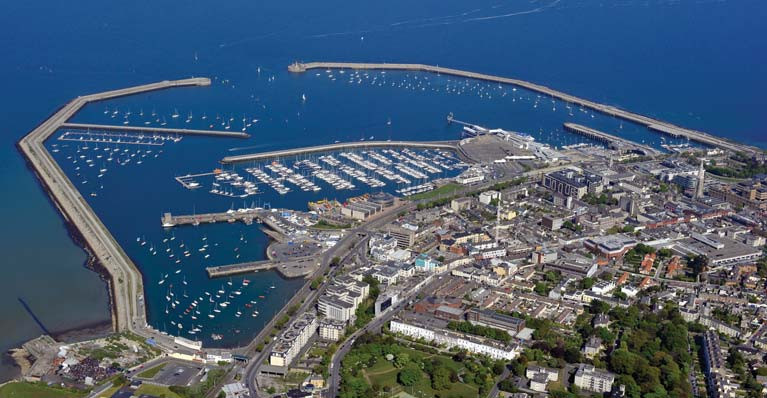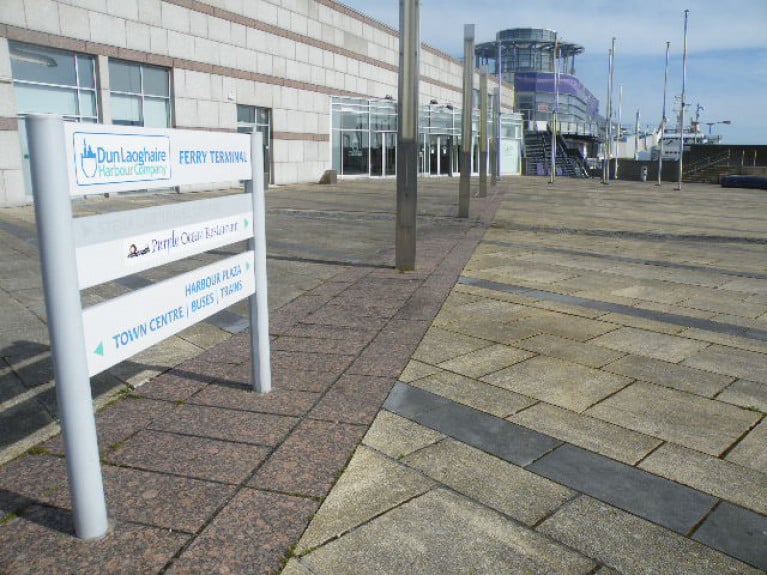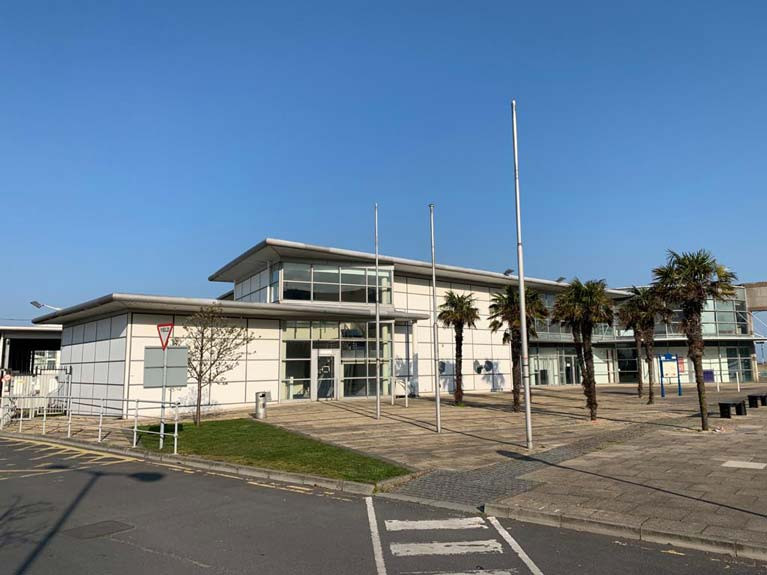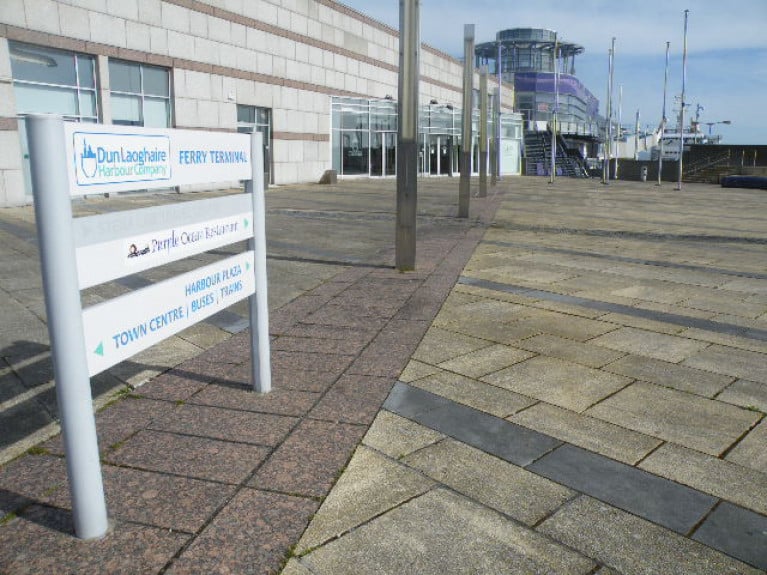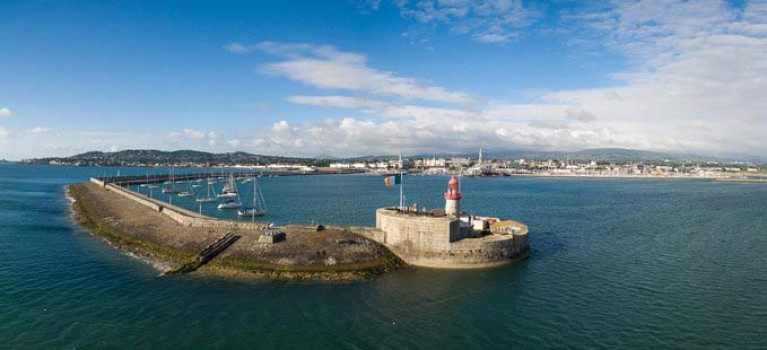Displaying items by tag: Dun Laoghaire Harbour
Dun Laoghaire Harbour Bye-Laws Downloadable Here!
Dun Laoghaire Harbour Bye-Laws are downloadable below.
The attached, inter alia, are prohibited and made offences by the Harbours Act, 1996 and persons so offending are liable on conviction to the penalties provided for by the Harbours Act, 1996, Section 6, namely on summary conviction to a fine not exceeding €1,904-60 or imprisonment for a term not exceeding 12 months or both (Section 6(1)(a)) or on conviction on indictment, to a fine not exceeding €126,973-80 or imprisonment for a term not exceeding 2 years or both (Section 6(1)(b)).
Two visiting yachts arrived into Dublin Bay on Easter Sunday afternoon despite COVID-19 emergency restrictions that have closed the town marina at Dun Laoghaire, shut down all local boating activity and put the harbour into lockdown under Government guidelines.
A northeasterly gale is forecast this evening and even though new travel restrictions have been extended to include “the arrival of personal non-national maritime leisure vessels", a visitor can avail of 'port of refuge exemption' if required under the Dept of Health and Dept of Transport COVID-19 regulations.
The first yacht (with GBR Sail insignia) moored at the East bight at Dun Laoghaire at noon. The other visitor, with reefed mainsail and flying the UK's red ensign, tacked around Sandycove and Dalkey in the south of the Bay.
Easter represents the start of the boating season at Dun Laoghaire Harbour but with all four yacht clubs closed and the lift in of boats cancelled too, the waterfront that should typically be a hive of activity was instead silent.
Afloat sources understand one of the boats is hoping to resupply in Dun Laoghaire and its final destination is Scotland.
The Coastguard and RNLI have asked boaters to stay off the water to assist emergency services during the COVID-19 crisis. It is an advisory message that appears to have been well observed on Dublin Bay at least, save for one or two stand-up paddleboards (SUP) and a small number of coastal kayakers during Saturday's sunshine.
How Secure are Dun Laoghaire Harbour Piers?
Donal O'Sullivan muses on the implications of a forgotten financial scandal at Dun Laoghaire Harbour
John Rennie, the eminent Scottish engineer who drew up the original plans for Dun Laoghaire Harbour, was destined never to see them come to fruition. He died on the 4th October 1821, many years before the harbour had begun to take its present shape.
There is not the slightest suggestion anywhere that his death was of anything but of natural causes. “The disease which killed my father was that of the liver and kidneys”, wrote his son, Sir John Rennie, FRS, in his being autobiography. (Sir John later succeeded his father in overseeing the project). There is further evidence of his illness in the minutes of the harbour Board where it was recorded, a few months before his death, that Rennie the Elder was too unwell to provide a report on the progress of the works that the harbour commissioners had been looking for.
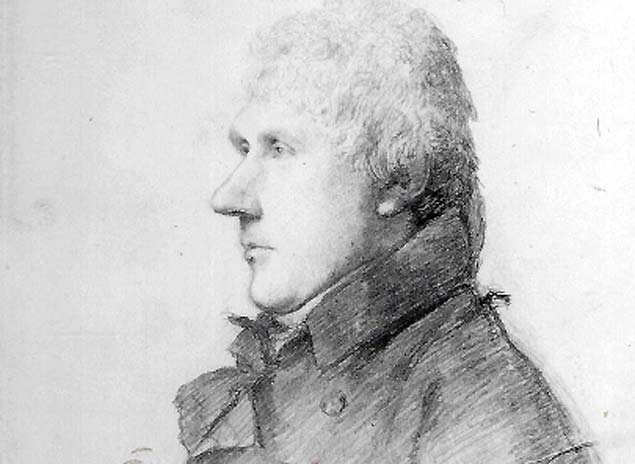 A portrait of John Rennie (the Elder). Reproduced with the permission of the National Portrait Gallery, London
A portrait of John Rennie (the Elder). Reproduced with the permission of the National Portrait Gallery, London
It’s worth mentioning this all this because at one time you could meet locals who would assure you, with the utmost conviction, that “the engineer for the harbour” had put an end to his own life because, allegedly, “he put the piers in the wrong place”. That, to put it mildly, is pure folklore; suffice it to point out that that the only serious question that ever arose about John Rennie’s plans for Dun Laoghaire Harbour concerned another matter altogether - the width of the harbour mouth.
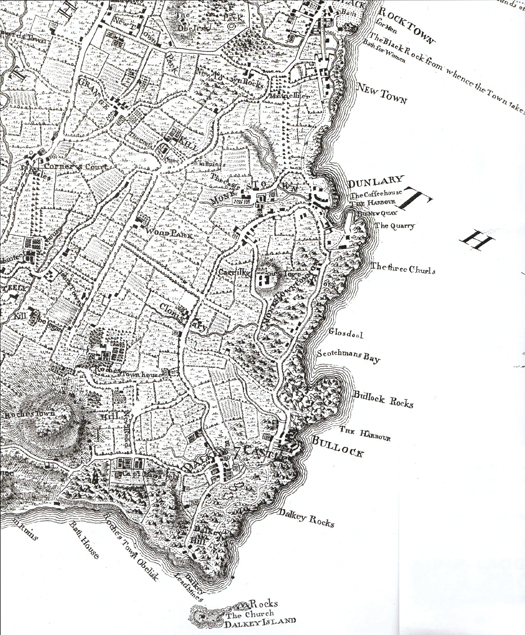 The coast at Dun Laoghaire before the harbour was built. The harbour of Old Dunleary, in the area still known as The Gut, was a shallow creek in the southwest corner of the new harbour
The coast at Dun Laoghaire before the harbour was built. The harbour of Old Dunleary, in the area still known as The Gut, was a shallow creek in the southwest corner of the new harbour
"The entrance was too narrow, they thought, for ships that would have to tack through it"
This was a contentious issue first raised by the captains of the squadron accompanying George IV during his Irish visit. It was too narrow, they thought, for ships that would have to tack through it. The contrary view, argued with much vehemence, was that a widening it would deny vessels inside the protection from easterly winds that was the primary purpose of the Harbour. The argument rumbled on for years and was finally decided when the Admiralty pressurised the Board of Works (by then in charge of the Harbour) to provide a mouth 200 feet wider than that proposed by Rennie. Perhaps the only sensible verdict on the whole matter might be the opinion in a report in 1855 of Captains Kellett and Frazer that “perfect security and facility of access are so antagonistic that one must be chosen”.
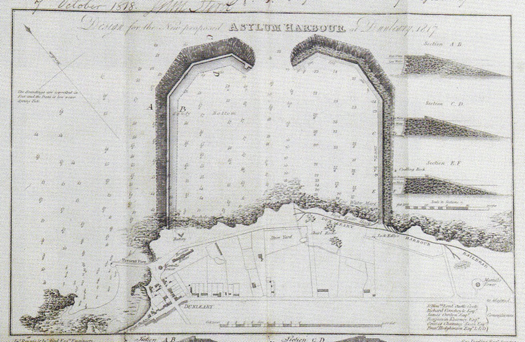 The first plan for the new harbour in 1817. The entrance was made wider in the finished version, and the West Pier was built further west to enclose the Old Dunleary harbour
The first plan for the new harbour in 1817. The entrance was made wider in the finished version, and the West Pier was built further west to enclose the Old Dunleary harbour
All that aside, while few would fault Rennie on his plans for the harbour, how some of those plans were executed is quite another matter – at least on the financial side and possibly on the technical side as well. Early in 1829, a dispute broke out between the harbour board and then - quarry contractors, Sam Smith and Bargeny McCulloch, about the use of quarry rubbish or shingle to cover the beech then existing on the shore between the piers - there were plans for a boat quay. (The original contractor was George Smith who died in September 1825 and was succeeded by his son, Sam, and son-in-law, Bargeny McCulloch).
Smith and McCulloch would have been wiser to have avoided such an argument, because it sent a financial subcommittee of the Harbour Commissioners, who were new to the job, back a to the original contract for working the quarries in Dalkey and delivering the stone to the pier heads.
What they found appalled them. Firstly there was an issue about the proportion of large blocks of stone to rubble stone - five of the former to two of the latter. The original specification on which the contract was based stipulated two to five; the proportion had been reversed by whoever drafted the contract. The large blocks were very valuable, measuring five to two cubic yards. “Many of them”, said the report, “admit of being squared or dressed so as to be used in facing or finishing the piers or quays and for which the contractors are paid 1/3d additional”. The rubble was not to be less than one and a quarter cubic foot. The stone was paid for at 3/- per cubic yard on the amounts of stone excavated “without the delivery being checked or counted in respect of the quantity or description delivered”.
But most serious of all, as they say in their report, the contract “was silent as to quarry rubbish. In fact, the use or disposal of it does not appear to have been contemplated by the contracting parties. Notwithstanding which, immense quantities were applied in the formation of both piers- but more particularly in forming the west pier—and paid for at the rate of 3/-per cubic foot “ i.e the price for the large blocks. To drive home the enormity of this, the authors of the report helpfully points out that in their letter of the 23rd of September 1829 the contractors “have offered to deliver shingle or rubbish to the beach on or between the piers at the rate of 10p per cubic yard”
Further on in the report, there is a curious observation. In criticizing the practice of “of paying the contractor by measurement without reference to the quantity or kind of material is delivered” they add the phrase ”in practice injurious to the stability of the work”.
This offhand, throwaway remark seems to have never received any attention. Understandably, perhaps, with the main focus at the time being on the financial implications which, in truth were quite serious. The report had spelt it out starkly. “Your committee apprehend that if the committee for auditing the public accounts called for the contract - they would disallow the account and report the facts to the government with their opinion thereon”. (Of the stability bit, more presently).
Nowhere in the records is there any suggestion that anyone on the harbourside had anything to gain personally from this maladministration of the contract. Neither of the two Rennies, to whom Dun Laoghaire (then Kingstown) Harbour was just one of many projects occupying their minds. Nor the Harbour Commissioners, local worthies who showed exemplary zeal in protecting the public purse. Nor John Aird, the resident engineer appointed on Rennie’s advice who certified the payments – an awkward, contrary sort of man, you might think from his letters the harbour minutes, who sometimes protected the workforce from the penny-pinching proclivities of the Commissioners. It just seems to have been one of those unfortunate things that happen in organisations when practical, busy men take their eyes of what they too often dismiss as “just paperwork”.
And yet, from the very outset, there was something odd about the Dun Laoghaire Harbour contract. Hardly had it been signed, when the Harbour Commissioners had to deal with a worrisome letter from a west of Ireland contractor called John Behan., directed to the Viceroy, Earl Whitworth He claimed that his tender was lower than that of George Smith, who had been allowed to lower his prices to bring his prices below those of Behan. He intended no disrespect to the Harbour Commissioners; he just felt that their judgement had been influenced by Rennie in favour of his fellow-countryman” (ie Smith).
Behan’s letter contained a sentence which the Commissioners must have found unsettling: Behan presumed “to think that Your Excellency may also think this matter to be of public importance, involving the integrity of public competition so eminently upheld during Your Excellency’s administration”
But Rennie deal with this smoothly enough. He, for his part, intended no disrespect to John Behan, with whom he was personally unacquainted, but he made no bones about his partiality for Smith, who had long experience in the quarrying, dressing and removing stone in the neighbourhood of Bulloch, and who had long skill in the execution of masonry of this sort. He had also a large number of workmen employed in the quarries in the neighbourhood; he, Rennie, had personal experience of the excellence of Smith’s work when he worked for him on the Howth Harbour project. There was also his fear that a higher price would have to be paid should Behan fail in the execution of his contract. Ultimately it came down to whether the commissioners had confidence in Rennie’s judgement and on that there could be no doubt or argument.
For good measure, the Harbour Commissioners added their own few tuppence. After tendering Behan, apparently, had asked that his proposals to be returned to him and then informed them that he intended increasing his prices by 12 1/2 %, which gave the Commissioners the impression that Behan did not really know what he was getting himself into.
As to the assertion that their decision “was influenced by persons in their employ in favour of their countryman Smith,” they added that they “submit that so gross and unfounded an insinuation is best repelled by the well-known honour and integrity of Mr Rennie”.
Then there was the curious matter of John Aird and Alexander Nimmo, a dispute that the Commissioners had stumbled into inadvertently. In October 1817, as the work had begun to get underway, the Commissioners appointed Nimmo, another engineer, to conduct a survey of the quarries. Aird took umbrage, claiming that the appointment undermined his own authority. He wrote a most intemperate letter to the commissioners, telling them, inter alia, how much he despised the motives that inspired the appointment.
Very much taken aback at what they had unloosed, the Commissioners asked Rennie, who had appointed Aird, what he thought. Rennie confirmed that Aird’s authority would indeed have been undermined – and indeed reflected on himself - but the letter was most unfortunate and he then diplomatically made some procedural proposals that would meet the Commissioners requirements. Nimmo soon departed, job done, supposedly, and the controversy died down. But thirteen years later, the Commissioners must have wondered whether they should have stood their ground and insisted on independent verification of what was happening at the quarries
And all this quarry shingle “immense quantities - used in the construction of both piers” which “in practice” was “injurious to the stability of the work”? The stability element, in fact, never seems to have trouble anyone overmuch, certainly not Rennie himself – Rennie fils, that is – who in a report of his site visit soon after the Commissioners’ discovery, did not mention it all.
Both the Rennies, in fact, took great pains in securing the foundations of the piers and laying down the glacis, the seaward stone slope that protects the walls of the piers. Rennie pere himself had even specified the type of mortar to be used underwater: pozzolana – a mixture of lime and volcanic ash, used in pier construction since the days of the Caesars. Not the Naples variety, he emphasises but material from another site near Rome, Cavo di San Pablo.
But now since the storm of early March 2018, that phrase “injurious to the stability of the work” has taken on a certain relevance. The West Pier took quite a battering part of the plinth of the DBSC Hut having been swept away. But at the East Pier, such was the force of the wind and wave that the sea penetrated the top of the glacis, allowing the water to gain the interior of the East Pier and the waves that penetrated the interior of the pier met no resistance - except perhaps shingle - burst open the paving at the shelter on the upper walkway. On the whole, however, the pier walls stood firm and Dun Laoghaire was spared on this occasion the type devastation experienced across the channel.
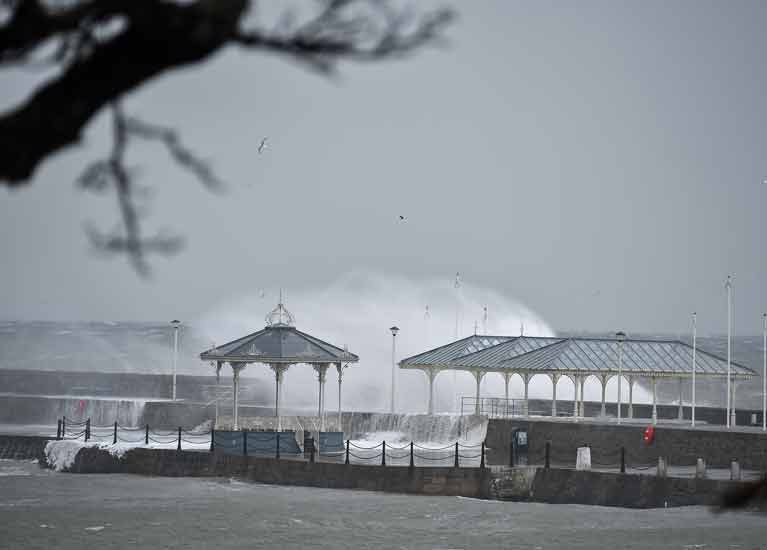 Waves lash Dun Laoghaire harbour's East Pier during Storm Emma causing substantial damage below. Photo: Michael Chester
Waves lash Dun Laoghaire harbour's East Pier during Storm Emma causing substantial damage below. Photo: Michael Chester
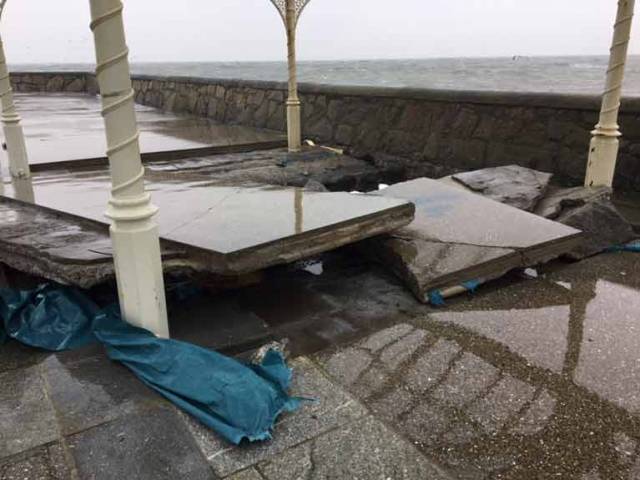 The broken surface at the bandstand area of the East Pier following Storm Emma in March 2018
The broken surface at the bandstand area of the East Pier following Storm Emma in March 2018
Given the current assumption that gales of this variety are likely to occur more frequently in the future, is it reasonable to accept that Dun Laoghaire Harbour will continue to be able to withstand the extremes of weather that are supposed to come our way? Knowing what’s inside some parts of the piers, you might wonder.
 Repair work shows the extent of storm damage to the East Pier Photo: Afloat
Repair work shows the extent of storm damage to the East Pier Photo: Afloat
Coming back to the matter of the Smith contract – the firm had become Smith and McCulloch since the founder George Smith had done in September 1825 - things could not continue as before. There was a legal problem, however in cancelling the contract and the Solicitor-General was not optimistic that the jury would find in the Board’s favour in relation to some aspects of the dispute. In fact, everyone involved was tainted to some extent, including the Commissioners had acquiesced in paying the account and their resident engineer who had signed it. There was also the matter of the thirteen years during which the irregularities had gone unchallenged.
However, he recommended an expedient: oblige the contractors to adhere to the strict letter of the contract and deliver large block stone and rubble at the proportion of five of the large stone to two of rubble. This was clearly impossible and the Smith and McCulloch, recognising that the game was up, withdrew from the contract on the 25th January 1830. A new quarrying contract was later signed with another firm, Henry Mullin and McMahon.
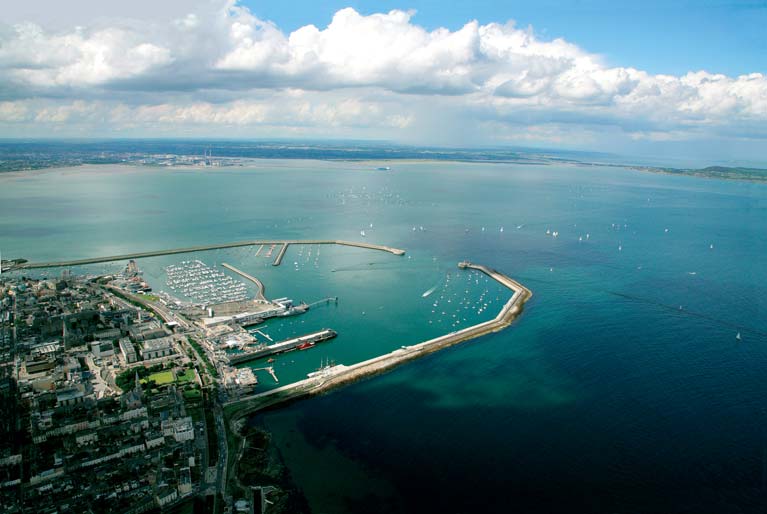 A view from the south looking over Dun Laoghaire Harbour Photo: Peter Barrow
A view from the south looking over Dun Laoghaire Harbour Photo: Peter Barrow
The Board of Works took over Dun Laoghaire harbour on the 31st July 1832 and in the name of efficiency immediately made a clean sweep of the entire harbour establishment. (You might wonder if they knew what had been going on in the quarries) Aird’s salary was reduced from £500 to £300; they were not reducing Mr Aird’s salary as such, they told him –they were just announcing their intention to employ an engineer at £300 a year. Aird was possibly under some stress at the time. He had a stroke some months later- on the 26th November and died on the 8th October the following year.
"His request of a loan of a cart to bring his belongings to Dublin was turned down"
George Darling, the very able secretary and accountant to the outgoing board, was dismissed, there be no longer any need for his services. He went blind at this time and was being assisted by his son, Charles. His request of a loan of a cart to bring his belongings to Dublin was turned down.
The Board of Works testimonial read: “ He has performed his duties in a most efficient and praiseworthy manner”, adding the ungracious qualification “as far as their limited knowledge of the affairs of the harbour will admit them to form a judgement”. Darling must have got some satisfaction a year or two later when they had to send him quite a polite letter asking for his help with a legal issue.
And the Smiths? They went into house building and some of their houses are still standing today. Not unexpectedly, their building methods could be open to scrutiny. One house owner, failing to drive in a nail into a wall to hang a picture, found behind the plaster a block of granite. From Dalkey quarry no doubt. A few feet away, no problem at all – just shingle mixed with horsehair.
Much of the above first appeared in a book on the history Dun Laoghaire written in Irish by the former Hon. Secretary – O Kingstown go Dun Laoghaire. It was published in 1976 by Foilseachain Naisiunta Teoranta
The sources are chiefly the minute books of the proceedings of the Commissioners of Kingstown Harbour, Board of Works, National Archives: OPW Piers & Harbours. Part 1. 1/8/6/1-5 and 1/8/7/1.
New Ferry Terminal ‘Innovation Space’ Plans Could Create More Than 650 Jobs In Dun Laoghaire
More details have emerged of new plans for a technology hub at the site of the former Stena ferry terminal in Dun Laoghaire.
Lapetus Investments Ltd, trading as Quarterdeck Innovation, envisions a “co-working innovation space” within the St Michael’s Pier terminal building in Dun Laoghaire Harbour.
It intends “to create a technology hub whereby small and medium-size businesses can collaborate in a community-based environment that promotes and fosters entrepreneurship, through a spirit of innovation and creativity”.
The project team is led by accountant Hilary Haydon, a past president of Dun Laoghaire-Rathdown Chamber of Commerce and DLR Local Enterprise Office evaluation committee member.
And it’s hoped the scheme could create more than 650 jobs after five years in the south Dublin port town — which will pique the interest of the waterfront yacht clubs among many other local stakeholders.
 From Ferry terminal to state-of-the-art innovation campus - plans are in place to transform the old building Photo: Afloat
From Ferry terminal to state-of-the-art innovation campus - plans are in place to transform the old building Photo: Afloat
Key benefits touted by Quarterdeck Innovation include generating value of €10 million to Dun Laoghaire-Rathdown County Council over its first 10 years, as well as a local spend of €5 million annually.
And the project emphasises integration with its location, positioning the hub as particularly attractive for marine technology and research.
Lapetus/Quarterdeck intends to repurpose the building’s interior as a “state-of-the-art innovation campus” proposing “sensational sea views from almost every desk”.
In addition, its ground floor level would be a ‘Food Hall’ acting as a common area for co-workers to relax away from their desks, and which would also be open to the public as “an opportunity for strong local community interaction”.
The project partners have also pledged to “assist and collaborate closely” with the feasibility study team for the National Watersports Campus being proposed for Carlisle Pier to help “improve the harbour’s infrastructure resulting in improved access, job creation and strong tourism potential”.
Proposals to develop the former Stena ferry terminal were first made in 2017 but later scrapped over licensing issues.
Much more recently, the site has been suggested by a local senator as a base for a Covid-19 testing centre amid the current coronavirus pandemic.
Dun Laoghaire Ferry Terminal Suggested As Covid-19 Testing Site
A Dun Laoghaire senator has suggested that the currently vacant ferry terminal at the south Dublin harbour be employed as a Covid-19 testing centre.
In a letter to Dun Laoghaire-Rathdown County Council chief executive Philomena Poole, as seen by Afloat.ie, Senator Victor Boyhan says the St Michael’s Pier terminal building “would be ideal as a drive-in Covid-19 testing and support centre”.
He outlines a number of reasons for this, which include “its proximity to population along the east coast, its size, facilities and car capacity, and that it is disconnected from the principal residential quarter of the town”.
He continues: “Planning permission would not be an issue, given the emergency powers in place to deal with the Covid-19 pandemic and the temporary nature of the use.
“The harbour terminal buildings extend to about 7,000 sq m (75,000 sq ft) with large, open-plan internal spaces and a wide range of facilities on the site.
“The property has 95 car-parking spaces for occupiers and visitors along with additional roll-on-roll-off car standing facilities that were put in place for the car-ferry service.
“Public transport including the Dart and a number of Dublin Bus routes are within a two-minute walk of the complex, so the site is very accessible to the general public – an important consideration.
“In simple terms, the site is ideal as an emergency Covid-19 testing and support centre.”
Senator Boyhan adds that he had contacted HSE bosses and Health Minister Simon Harris suggesting they explore the suitability of the site with DLRCoCo.
Dun Laoghaire Ferry Terminal Plans ‘Could Be Trojan Horse For Unsuitable Development’
Dun Laoghaire Harbour is on the verge of an investment and development boom — but the unknown provenance of one investor in a key waterfront asset gives pause for thought, writes local resident Paddy Shanahan.
Lapetus Investments Ltd has submitted a planning application to take control of the former Stena ferry terminal by way of a 15-year lease which Dun Laoghaire-Rathdown County Council will be voting either for or against on Monday (10 February).
The investor has also applied to change the ground floor restaurant, in plans for a mixed-use co-working space agreed last year, to a food court — a move backed by at least one local stakeholder.
Readers will be aware that several hundred different stakeholders have agitated for Dun Laoghaire Harbour to be developed as a marine sports campus. And the Council Executive have recently agreed that a marine sports campus is the future for Dun Laoghaire Harbour.
Opening the harbour to the general public paves the way to regeneration of the town centre and an investment thesis that will open up many opportunities bringing in many investors.
Less than two weeks ago, €400,000 was secured from the Government for a feasibility study on the marine campus project; the follow-on investment would be many millions and a boon to Dun Laoghaire.
The terminal building is the jewel in the crown and will be at the centre of proposed marine sports-related initiatives and/or businesses.
However, Lapetus Investments are unknown, and provide no information about themselves only that they wish to build an innovation hub. That should be unacceptable to elected councillors.
The terminal building is the jewel in the crown, and will be at the centre of proposed marine sports-related initiatives and/or businesses
Any development in the harbour and its historical and protected assets should require full disclosure and prior discussion. Anything less is a disservice.
Extremely worrying, and a major red flag, is their application to remove condition number two of the previously granted planning permission, which was placed to ensure the development remains compatible with the Dun Laoghaire-Rathdown County Development Plan 2016-2022.
From the DLRCoCo documentation, the condition states: “This permission shall be for a period of 10 years from the date of the final grant of permission. Four years from the final decision date, the Applicant shall submit a full review/monitoring report, together with floor plans, in respect of the permitted use detailing the overall use and corresponding floor area, demonstrating that the development remains consistent with the particulars of this permission.
“At the end of the 10-year period, the use of the building shall cease unless, permission for its continuance and/or change of use (as required) has been granted by the Planning Authority or An Bord Pleanála on appeal.”
A technology hub is worthy of serious consideration. However, under the terms of their application they wish approval for, Lapetus could use the proposed tech hub as a Trojan horse for other development which goes against all principles of what we, the council and many others are fighting for.
Their application precedes the grant of the feasibility study funds. As such, any vote needs to take place only after the feasibility study is complete and more is known about Lapetus.
Any councillor who votes for granting this lease will be doing so against the wishes of a great many residents of Dun Laoghaire-Rathdown.
All stakeholders in the harbour should remain vigilant on this issue, and I urge all who would agree to pass their concern on to DLRCoCo councillors and urge them to vote against the application until all the facts are clear and the study is complete.
Watersport School To Open New Hub At Dun Laoghaire’s Coal Harbour
Irish watersport school BigStyle has announced the development of a new hub for stand-up paddleboarding at Dun Laoghaire’s Coal Harbour.
The news comes just months after the business, which has expanded as far afield as East Africa, mooted plans for a more permanent base in Dun Laoghaire, where one of its founders grew up.
The new facility will be constructed from renovated shipping containers, in a similar fashion to the Irish Sailing Performance HQ opened in the harbour last year.
BigStyle says its new space will comprise ‘chill-out areas’, changing rooms, clothes and equipment storage, direct access to the water “and a whole lot of charm”, along the lines of its own Atlantic Lodge for the surfing community in Co Mayo.

“Above all we want to be as environmentally conscious as possible — the building will be totally off grid with solar panels, a water harvester, 12v power and as little single use plastic as possible,” the business says.
While the main purpose of the space will be the SUP school, BigStyle also plans to have a surf shop and a simple coffee shop, and will also make room for the Clean Coasts initiative to spread awareness, launch clean-ups and hold various events.
The space is currently scheduled to open just over three months from now, at the beginning of May, “and we’re confident that this will help reinvigorate an often overlooked area of the harbour”, the company adds.
Dun Laoghaire Harbour Master Issues First Notice to Mariners of 2020
Dun Laoghaire Harbour Master Simon Coate has issued the first notice to Mariners of 2020 for the Dublin Bay harbour as a reminder which notices remain in force.
- No. 7 (2010) - Discontinuation of Fog Signal
- No. 6 (2013) - Disestablishment of ‘Traffic Operating Lights’
- No. 7 (2014) – Marina East & West Breakwaters – Alteration of Character, Synchronisation of Lights and
Installation of Topmarks - No. 8 (2014) – Permanent Withdrawal of Dun Laoghaire Buoys Nos 1 & 2
- No. 6 (2016) – No 1 Berth Permanently Closed to Shipping
- No. 8 (2016) – No 3 Berth Permanently Closed to Shipping
- No. 9 (2017) – St Michael’s Pier NE Pile Change to Light Character
- No. 5 (2018) - Use of Unmanned Aerial Vehicles (UAVs) / Drones
- No. 9 (2019) – Relocation of Cruise Ship Tender Pontoon
All other Dun Laoghaire Notices to Mariners are automatically cancelled at 23:59 hours on the 31st December 2019. At that time 2020 Notices to Mariners will come to in to force until specifically cancelled or until 23:59 hours on the 31st December 2020.
Dun Laoghaire is undoubtedly a harbour which merits study. So much so, in fact, that as of this week, the qualifications for detailed study of the magnificent artificial harbour and the remarkable town beside it have been quantified - to the cool tune of €600,000 in all -for research and report on development.
It’s a tidy sum. Yet it’s real enough. Back in September, we referred to the two analyses which Dun Laoghaire Rathdown County Council had put out to tender for €100,000 each, one for research and conclusions on how best to develop the harbour/township waterfront area, and the other – for an identical amount – for recommendations on putting new life into the rundown parts of the town itself.
The harbour and the coastal location being Dun Laoghaire’s greatest assets, with the harbour the township’s ultimate reason for existence despite the fact that the original harbour planners didn’t take the creation of a township into account, we’d have thought the two projects were the two sides of the same coin. But even with them being separate contracts, the fact is that by the end of 2019, €200,000 had set aside for these specific expenditures, and the research work was underway.
But as of this week, those two smaller studies have been put in the shade by the very clear announcement by the Department of Transport, Tourism & and Sport that a feasibility study - costed at €400,000 - will be Government-commissioned to progress the €8 million National Watersports Campus proposed for the harbour by Dun Laoghaire Rathdown County Council, working in concert with Irish Sailing and the Irish Underwater Council, and supported specifically by Triathlon Ireland, Rowing Ireland, Irish National Sailing & Powerboat School and Canoeing Ireland, with additional support from nearly 40 other organisations – including the yacht clubs - which use the harbour and its environs in one way or another.
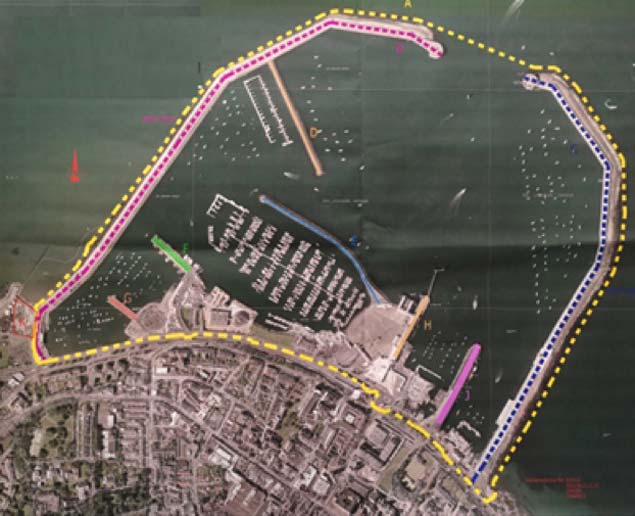 The proposed National Watersports Campus is envisaged as being the entire area within the yellow-dotted line, including all the waterfront shoreside area to seaward of the railway line.
The proposed National Watersports Campus is envisaged as being the entire area within the yellow-dotted line, including all the waterfront shoreside area to seaward of the railway line.
Getting so many different organisations and interests to pull together and work in support of what is ultimately a Local Government initiative has been a monumental task of patience and persistence, and painstaking attention to detail. For in the end, the fact that the Dun Laoghaire proposal was one of the few that won out, in what was effectively a national competition involving many possible projects applying to the Large Scale Sports Infrastructure Fund (LSSIF), was a matter of covering every angle from the effect on the local economy – particularly employment – to the environmental impact, while working in with the fact that anything which makes participant sport more accessible and welcoming chimes well with national policy on improving people’s health and sense of wellbeing.
The proposed National Watersports Campus will also play a key role in bringing much more life to the Dun Laoghaire waterfront, as it would be expected to function on a seven days a week basis, certainly from March to November, and probably year-round. And once you start getting such activity being the norm at one of the most visible parts of the harbour (for the already busy Irish National Sailing School is somewhat hidden away in the inner recesses of the Coal Harbour to the westward) the perceptions of the harbour as a place only of seasonal activity and vitality will change, and the sometimes weak interaction between town and sea will become more dynamic.
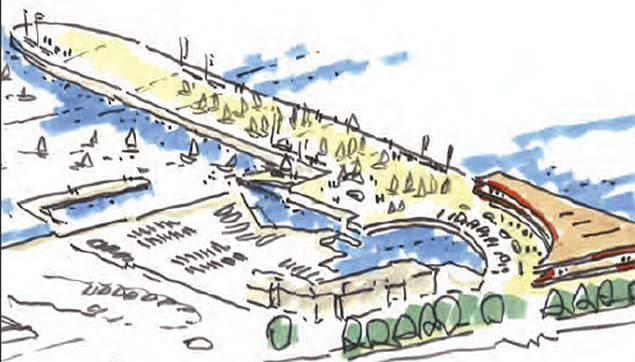 A preliminary artist’s sketch of the possible layout for the National Watersports Centre at the south end of the Carlisle Pier, with a large-scale all-tides slipway on the pier’s west side
A preliminary artist’s sketch of the possible layout for the National Watersports Centre at the south end of the Carlisle Pier, with a large-scale all-tides slipway on the pier’s west side
But all these things would not have become possible as of Monday this week had it not been for a long period of what might be called good work by stealth by a visionary group. Good work by stealth is perhaps the only truly good work, except that “stealth” suggests subterfuge, whereas this has all been about many hours and days – years even – of discussion, planning and quiet meetings and then yet more meetings, always through official channels but without making a song and dance about it.
From time to time here in Afloat.ie we’ve alluded to the proposed developments gradually taking shape, but have tried to respect the fact that those involved are doers rather than talkers, except when talk is needed to progress the project. Thus we’re in the odd position of mentioning all the main organisations which are involved without mentioning any single person’s name, and that is the way that those who got this particular ball rolling would like it, for until the official announcement was finally made, nothing was absolutely certain.
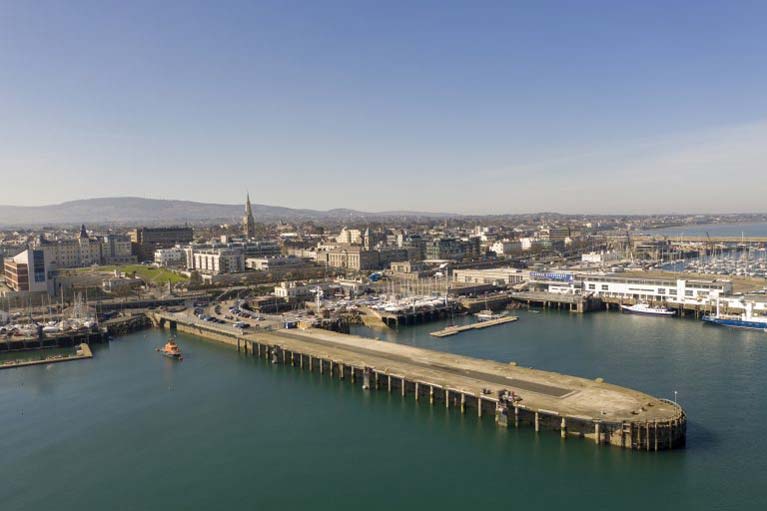 Carlisle Pier is in a sorry state, its outer end in the heart of the harbour inaccessible, and the inner end utilised as a car park. Photo courtesy Barrow Coakley/Simon Coate
Carlisle Pier is in a sorry state, its outer end in the heart of the harbour inaccessible, and the inner end utilised as a car park. Photo courtesy Barrow Coakley/Simon Coate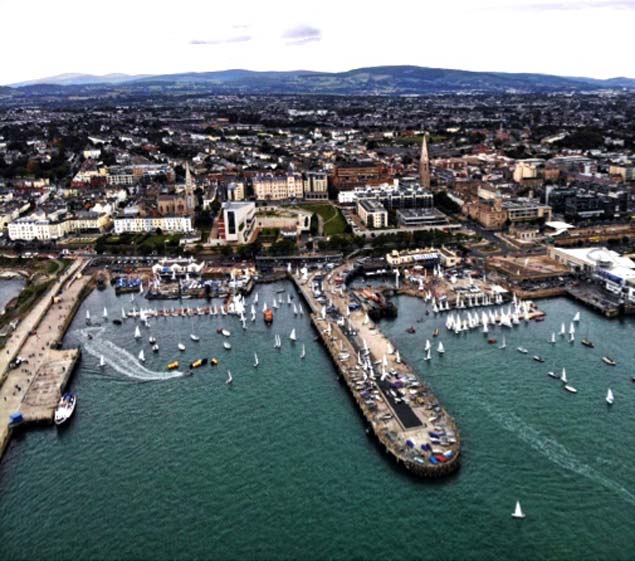 Carlisle Pier brought temporarily to life for the Laser World Masters, September 2018. Planning for the new National Watersports Centre was able to draw on experienced gained from this event in which more than 300 boats took part
Carlisle Pier brought temporarily to life for the Laser World Masters, September 2018. Planning for the new National Watersports Centre was able to draw on experienced gained from this event in which more than 300 boats took part
Maybe the sudden imminence of a General Election had something to do with this week’s surprise revelation of good news. Whatever, it certainly brightened up a Monday morning in January to learn that we were having one of those rare experiences when boat users of all kinds - and harbour users of every sort in Dun Laoghaire - seemed to be on the right side of politics, and of history too.
For talk of “history” is not over-stating it. The final shape of Dun Laoghaire’s extraordinary artificial harbour – so monumental that people think of it as a natural feature of Dublin Bay – was not finalised until the 1820s, even though construction had been started in 1817. But once it had been finalised, that was it – the outer limits of the great harbour had been set, and have remained the same ever since.
 Set in stone. Any plans for modern facilities in Dun Laoghaire Harbour have to take account of the fact that the basic outer shape was unchangeably set 200 years ago. Photo Peter Barrow
Set in stone. Any plans for modern facilities in Dun Laoghaire Harbour have to take account of the fact that the basic outer shape was unchangeably set 200 years ago. Photo Peter Barrow
But within, there has been scope for development, and it has not always had happy results. The weakened state of the Irish economy in the 1950s meant that some cheap ad hoc arrangements had to be put in place to accommodate the growing size of cross-channel ferries. And as the ferries were the harbour’s main source of income, their needs became paramount, leading to the construction of the massive yet decidedly incongruous Ferry Terminal on the extensive St Michael’s Wharf site in the prime site in the middle of the waterfront, dwarfing everything else.
So too did the huge HSS ferries which it served. Yet while the ferries and the terminal may have grown, the narrow winding roads ashore stayed the same, with the increasing size of juggernaut trucks which the ferries brought in leading to traffic congestion and pollution. “Dun Lorry No Thanks” became the catch-phrase of early environmentalists in the late 1990s, yet it was harsh economics as much as environmental concerns which led to the final ferry sailing in 2015.
This meant that the Dun Laoghaire waterfront – where every inch of space should be regarded as valuable with potential positive uses – now had two former ferry terminals of substantial area in Carlisle Pier and St Michael’s Wharf, locations which were basically dead spaces, even if their quaysides provided berths for the occasional ship and large yachts.
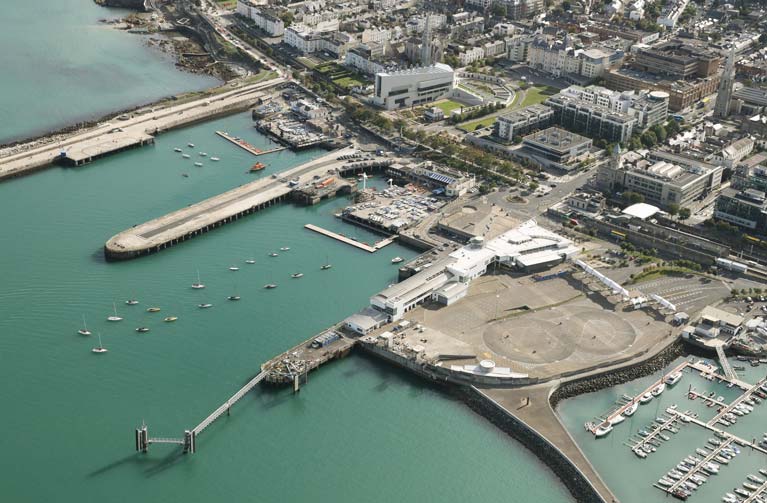 The eastern part of the Dun Laoghaire waterfront is blighted by the “dead spaces” of former ferry terminals at St Michael’s Wharf (foreground) and Carlisle Pier beyond.
The eastern part of the Dun Laoghaire waterfront is blighted by the “dead spaces” of former ferry terminals at St Michael’s Wharf (foreground) and Carlisle Pier beyond.
The utter lifelessness of these spaces has been emphasized by the fact that they are set between compact areas of intense maritime activity. To the eastward of Carlisle Pier is the busy National Yacht Club and the Dun Laoghaire RNLI base. Between Carlisle and St Michael’s, the Royal St George YC clubhouse with its forecourt/pontoons complex buzzes with life. Westward of the St Michael’s desert, the Marina and the Royal Irish YC snugly within it offer one of the best boat-berthing prospects in Europe.
Westward of the RIYC is the brief but welcome and revitalising waterfront of the Green, a very precious space. Beyond that, there is the Irish Lights HQ, and within it Irish Sailing’s Performance Group’s base – a temporary but vital facility which apparently will find a permanent home with the new National Watersports Centre.
Furthest west of all is the Coal Harbour, the Inner Harbour - call it what you will, and some would like to see it become more of a Heritage Harbour within the main harbour. But at the moment it’s an area where MGM Boats, St Michael’s Rowing Club, the Irish National Sailing School, Dun Laoghaire Motor Yacht Club and other organisations are making visionary and successful use of spaces which the original designers of the harbour left behind as by-products of their very fixed grand design two hundred years ago.
 A welcome focus of vitality – the well-maintained National YC is the most easterly of Dun Laoghaire’s waterfront yacht clubs and is celebrating its 150th anniversary in 2020
A welcome focus of vitality – the well-maintained National YC is the most easterly of Dun Laoghaire’s waterfront yacht clubs and is celebrating its 150th anniversary in 2020
Now, with the Council itself taking over the harbour and the harbour offices being re-located into County Hall, a new spirit of shared purpose has been gradually building as people recover from the prospect of the harbour being forced into domination by polluting cruise-liner berths in pursuit of what seemed like easy money and very questionable benefits. At last, there is a real sense of people, groups and organisations pulling together in order to see how best this extraordinary asset can be maximised for everyone’s benefit in many ways, with a healthy environment a top priority while at the same time retaining the harbour’s unique character.
It’s surely not overstating the case to suggest that the continuing success of the biennial Volvo Dun Laoghaire Regatta since its inception in 2005 has played a key role in developing this spirit of co-operation. It may seem absurd nowadays to think that it all seemed very novel at the time, but in those days the clubs all did things their own way, they relied on Dublin Bay Sailing Club to co-ordinate their weekly racing programme, and every year each club gave expression to its individuality with its own standalone regatta.
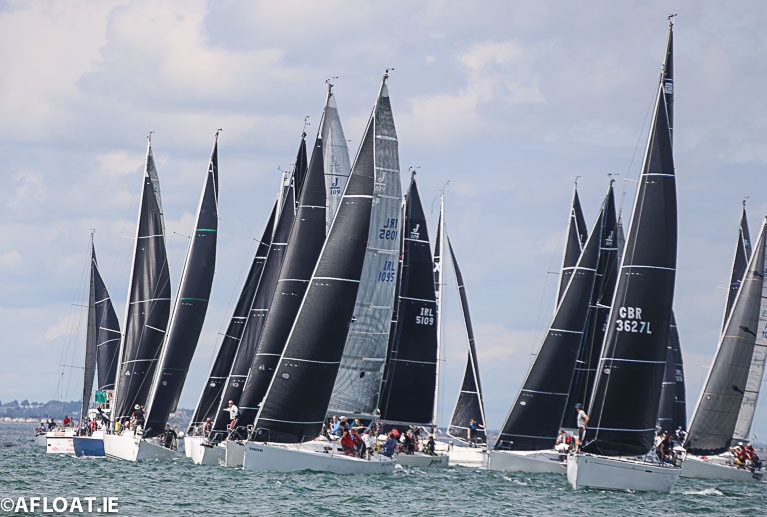 Volvo Dun Laoghaire Regatta in Dublin Bay. For fifteen years, this successful biennial event, the outcome of combined effort, has contributed greatly to the growing readiness of different organisations and the Council to work together in developing the harbour’s potential. Photo: Afloat.ie/David O’Brien
Volvo Dun Laoghaire Regatta in Dublin Bay. For fifteen years, this successful biennial event, the outcome of combined effort, has contributed greatly to the growing readiness of different organisations and the Council to work together in developing the harbour’s potential. Photo: Afloat.ie/David O’Brien
Certainly, there’d been attempts at regatta weeks in times past, but they’d always had the flavour of being one-offs. What was needed was a shared inter-club organisation which was in it for the long haul, and that came into being fifteen years ago, and has been going from strength to strength ever since, with the Council increasingly involved.
Then there was the shared emotion when Annalise Murphy of the National Yacht Club came home with her Olympic Silver Medal from Rio in August 2016. An Olympic medal is an Olympic medal regardless of whether or not one understands the ins and outs of the sport involved, and the magic day and night of Annalise’s return played its part in the slow process of changing perceptions of the relationship between town and harbour.
Yet if anything that changing perception emphasised the harbour’s general lack of convenient accessibility. At its most basic level, the prime location for simply viewing in-harbour activity would be from an observation area on the seaward side of the St Michael’s Wharf former ferry terminal and marshalling yard area. But it’s completely a no-go area.
 The conquering hero – Annalise Murphy returns to Dun Laoghaire with her Olympic Medal in 2016
The conquering hero – Annalise Murphy returns to Dun Laoghaire with her Olympic Medal in 2016
So too is the outer end of Carisle Pier. Certainly, you can stroll down the East Pier if you want to see the in-harbour activity, and there are reportedly 1.25 millions such strolls every year, though the majority are probably regular repeats. But for land-bound observers, there’s nothing to match being on the end of a pier within a busy harbour at a time of maximum activity afloat, and the fact that the end of Carlisle Pier is currently deemed unsafe is too typical of the way things had been going.
As for the inner sound section of Carlisle Pier’s use as a car park, it was convenient, it generates an income stream, but harbours are meant at the very least to be boat parks, not car parks, and in the case of Dun Laoghaire with its unrivalled areas of sheltered in-harbour sailing and boating water, a more meaningful boat-oriented use was needed for Carlisle Pier.
And that is going to be as the location for the new National Watersports Centre. The proposal is that all of Dun Laoghaire Harbour should be designated as the National Watersports Campus - an umbrella sort of description which can be interpreted in many ways – while the more specific focus for the Centre itself will be a new building on the inner end of Carlisle Pier beside storage parks for smaller boats of every kind, and with a king-size all tide slipway on the pier’s west side.
In terms of the way Dun Laoghaire might have gone astray, this complete concept is very definitely a major breakthrough in the right direction, not least in that its recognized permanence will bring with it lasting jobs which won’t leave Dun Laoghaire, jobs in the centre itself and supporting jobs in the many small businesses which will cluster around it.
For as one sage observer of the marine scene put it this week, however large scale Dun Laoghaire harbour itself may seem, the reality is that its waterfront and adjacent area is the function zone for many enterprises which, when rated by the number of people employed, are small businesses in the national sense of the term.
The yacht clubs, despite their grand histories with the National Yacht Club celebrating 150 years this year, are small businesses. Irish Lights may play a major role on the entire Irish coast, but when its total workforce is set against the thousands employed in the burgeoning tech industries elsewhere in Ireland, it is definitely a small business. As too is the marina, and the harbour itself if we separate its staff within their new Council environment.
 The proposed site for the location of the National Watersports Centre will transform the immediate harbour area. Photo: Barrow Coakley/Simon Coate
The proposed site for the location of the National Watersports Centre will transform the immediate harbour area. Photo: Barrow Coakley/Simon Coate
All these employees around the harbour are small businesses, yet between them they are a vital and significant part of the Dun Laoghaire economy, and the creation of the National Watersports Centre at the Carlisle Pier will be of primary importance in realising Dun Laoghaire true potential as an important part of building a healthier national lifestyle as we go through the 21st Century, while securing the future of existing and new small businesses.
That said, the transformation of Carlisle Pier is only the beginning – albeit an extremely welcome one - of the process of bringing new life to the “dead spaces” of Dun Laoghaire’s waterfront. But the complex discussion of what might happen to the spacious St Michael’s Wharf site with its former Ferry Terminal building is something for another day. For now, the go-ahead for the Feasibility Study and new life for Carlisle Pier is more than enough for the weekend.
Plans for an €8m National Watersports Campus at Dun Laoghaire Harbour got the green light from Government today with the announcement of a €400k feasibility study grant from the Large Scale Sport Infrastructure Fund (LSSIF).
The successful application was made by Dun Laoghaire-Rathdown County Council, Irish Sailing and Irish Underwater Council.
The new Campus plan includes a centre for community watersports activities, a public slipway and a High-Performance Coaching Centre. A mixed-use space for hosting international sailing championships, swimming, triathlon, rowing and canoeing is included. Accommodation facilities for NGB’s and Campus tenants are also planned.
The successful applicants were decided following a rigorous assessment process with the highest scoring applications receiving grant offers from Shane Ross T.D., Minister for Transport, Tourism and Sport, and Brendan Griffin T.D. Minister of State for Tourism and Sport.
A large group of Dun Laoghaire Harbour stakeholders combined forces to promote the project that they say will improve the Harbour’s infrastructure resulting in improved access, job creation and greater tourism potential.
The project recognises deficits in the current set up in the harbour, proposing the construction of an all-tide publicly-accessible slipway (none currently in the Greater Dublin Area) as well as a marine services facility, providing a much-needed home for the supporting industry.
The campus also seeks to provide a marketing framework to make boating more accessible to the general public.
The 'Stream 1' application at Dun Laoghaire is among those that seek funding towards the cost of developing projects to the point that an application for construction work can be submitted in the future.
More details on the Department of Transport, Tourism and Sport website here.


























